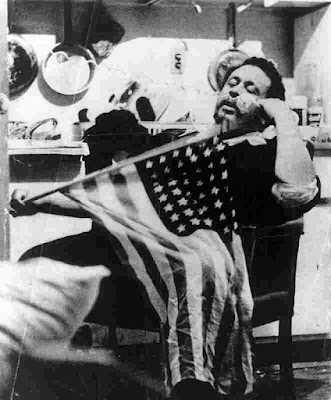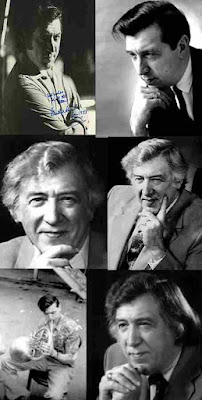I suggest you listen to the radio story before reading on. Can you guess which bit of the Camille excerpt caused me to decide immediately to buy that album?
Based on less than a seconds worth of sound I eventually purchased the album called Le Fil. Read about Camille here. Here's Camille's website where you can hear a couple cuts from Le Fil by watching videos.

Musically I find Le Fil completely involving, even intriguing. Plenty of vocal textures, vocal noises, vocal drones, overtone singing. There's hardly any instrumental backup. It's a very open, widely spacious, expansively empty album. Any one would like this (except minimalists and serialists.)
After several listenings I was surprised to discover many pages of lyrics in the booklet. I've always said I like pop music more if I can't understand the words. But French is a special case, filled as it is with non-human sounds to which my brain fails to assign linguistic meaning. And so I process the sounds not as language but as music. That's a good thing.
My second victim today is On Land and in the Sea by the Cardiacs. I can't understand the words on this album either even though they're all in English. This is because the lyrics are all shouted rapid-fire over annoyingly loud rock and roll.
The Cardiacs are an English punk rock band. Just look at their picture. They look like a punk band, don't you think?

These two albums are as different as two albums can be. Well, one is French the other is English. One is a up and coming mega-pop star on a major label, the other is a decades-old under-ground independent-label noise band.
I ran across this video of "Tarred and Feathered" by the Cardiacs on You Tube months ago. I was smitten by the obvious weirdness and the crazy rhythm. Imagine that instead of going over to the dark side of 12-tonality late in life, Stravinsky had written punk rock music instead. Might have sounded something like this.
I searched for a Cardiacs album - the clerk at Canterbury's, the good Pasadena record store, asked me "Where do you find these things?"
Independently of this, I received an email from a gentleman in England named Ben Singleton. He wanted to ask me questions about my least favorite Frank Zappa album Thingfish. I noticed that on Ben's MySpace Page he had listed the Cardiacs among his favorite music.
After I answered Ben's question he offered to send me a copy of a Cardiacs album. After a short while On Land and in the Sea arrived as Ben's thank you gift. He's a nice guy. I hated the album. I even threatened to use it to drive Leslie out of my office when I wanted her to stop using my computer.
So what did I do after listening to this awful album a few times. I went to the Cardiacs website, of course, and ordered their greatest hits album. Maybe I did that to fulfill John Cage's commandment:
"If something is boring after two minutes, try it for four. If still boring, then eight. Then sixteen. Then thirty-two. Eventually one discovers that it is not boring at all."Or maybe I'm just a masochist.
Here are more Cardiacs videos to confuse you more. Enjoy them.
The Consultant's Flower Garden
R.E.S.
R.E.S.
A Little Man and a House

Here's some other recent Mixed Meters CD purchases:
Marc Blitzstein "The Cradle Will Rock" If you don't know this political musical I suggest you watch Tim Robbin's movie Cradle Will Rock as an introduction. MarcBlitzstein.com
Electric Gypsyland - I'm a sucker for these remix albums of East European brass bands like Tarif de Haidouks. I'm a sucker for Tango remixes too (like the Gotan Project) There's now an Electric Gypsyland 2 too.
The Puppini Sisters (their over-designed home page is here) - Betcha Bottom Dollar. Leslie requested this album. The close-harmony female trio formed, apparently, in response to the Mixed-Meters approved soundtrack to the animated movie Triplets of Belleville Hopefully in the future there will be other, more interesting, versions of I Will Survive done in the style of the Andrews Sisters.
Trance Fusion - a guitar solo only album by Frank Zappa that puts the Shut Up series to shame. (The uber-over-designed Zappa.com Trance Fusion page is here.)
Two discs of music by Rued Langgaard (1893-1952) - my brief investigation into reasons why composers are forgotten. Here's a Rued Langgaard website. I decided I needed to hear some of this Danish composers works when I read that the fourth phase of his creative career was entitled "Obstinacy and absurdity" Okay, I'm in.
Speaking of Danish composers. Here's a trenchant quote from a recent post by Roboflutist, a real working musician:
"Our audience wouldn't like the Nielsen. So which Mozart will you be playing?"Okay, I'm way off topic now. Leave a comment if you think you discern a common thread among all this. Or if you really want to know which tiny little bit of the Camille album started it all.
Album Tags: Camille. . . Cardiacs. . . Ben Singleton. . . Marc Blitzstein. . . Cradle Will Rock. . . Electric Gypsyland. . . Gotan Project. . . Trance Fusion. . . Frank Zappa. . . Puppini Sisters. . . Triplets of Belleville. . . Rued Langgaard. . . Roboflutist. . . John Cage




















